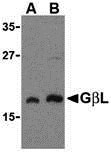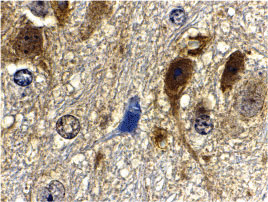GBL Antibody
- SPECIFICATION
- CITATIONS
- PROTOCOLS
- BACKGROUND

Application
| WB, IHC-P, IF, E |
|---|---|
| Primary Accession | Q9BVC4 |
| Other Accession | AAH52292, 30411038 |
| Reactivity | Human, Mouse, Rat |
| Host | Rabbit |
| Clonality | Polyclonal |
| Isotype | IgG |
| Calculated MW | 35876 Da |
| Application Notes | GbL antibody can be used for the detection of GbL by Western blot at 1 and 2 µg/mL. Antibody can also be used for immunohistochemistry starting at 10 µg/mL. For immunofluorescence start at 10 µg/mL. |
| Gene ID | 64223 |
|---|---|
| Other Names | GBL Antibody: GBL, LST8, POP3, WAT1, GbetaL, GBL, Target of rapamycin complex subunit LST8, G protein beta subunit-like, TORC subunit LST8, G protein beta subunit-like |
| Target/Specificity | MLST8; |
| Reconstitution & Storage | GBL antibody can be stored at 4℃ for three months and -20℃, stable for up to one year. As with all antibodies care should be taken to avoid repeated freeze thaw cycles. Antibodies should not be exposed to prolonged high temperatures. |
| Precautions | GBL Antibody is for research use only and not for use in diagnostic or therapeutic procedures. |
| Name | MLST8 {ECO:0000303|PubMed:34741373, ECO:0000312|HGNC:HGNC:24825} |
|---|---|
| Function | Subunit of both mTORC1 and mTORC2, which regulates cell growth and survival in response to nutrient and hormonal signals (PubMed:12718876, PubMed:15268862, PubMed:15467718, PubMed:24403073). mTORC1 is activated in response to growth factors or amino acids (PubMed:12718876, PubMed:15268862, PubMed:15467718, PubMed:24403073). In response to nutrients, mTORC1 is recruited to the lysosome membrane and promotes protein, lipid and nucleotide synthesis by phosphorylating several substrates, such as ribosomal protein S6 kinase (RPS6KB1 and RPS6KB2) and EIF4EBP1 (4E-BP1) (PubMed:12718876, PubMed:15268862, PubMed:15467718, PubMed:24403073). In the same time, it inhibits catabolic pathways by phosphorylating the autophagy initiation components ULK1 and ATG13, as well as transcription factor TFEB, a master regulators of lysosomal biogenesis and autophagy (PubMed:24403073). The mTORC1 complex is inhibited in response to starvation and amino acid depletion (PubMed:24403073). Within mTORC1, LST8 interacts directly with MTOR and enhances its kinase activity (PubMed:12718876). In nutrient-poor conditions, stabilizes the MTOR- RPTOR interaction and favors RPTOR-mediated inhibition of MTOR activity (PubMed:12718876). mTORC2 is also activated by growth factors, but seems to be nutrient-insensitive (PubMed:15467718). mTORC2 seems to function upstream of Rho GTPases to regulate the actin cytoskeleton, probably by activating one or more Rho-type guanine nucleotide exchange factors (PubMed:15467718). mTORC2 promotes the serum-induced formation of stress-fibers or F-actin (PubMed:15467718). mTORC2 plays a critical role in AKT1 'Ser-473' phosphorylation, which may facilitate the phosphorylation of the activation loop of AKT1 on 'Thr-308' by PDK1 which is a prerequisite for full activation (PubMed:15467718). mTORC2 regulates the phosphorylation of SGK1 at 'Ser-422' (PubMed:15467718). mTORC2 also modulates the phosphorylation of PRKCA on 'Ser-657' (PubMed:15467718). |
| Cellular Location | Lysosome membrane. Cytoplasm {ECO:0000250|UniProtKB:Q9Z2K5}. Note=Targeting to lysosomal membrane depends on amino acid availability: mTORC1 is recruited to lysosome membranes via interaction with GTP-bound form of RagA/RRAGA (or RagB/RRAGB) in complex with the GDP-bound form of RagC/RRAGC (or RagD/RRAGD), promoting its mTORC1 recruitment to the lysosomes |
| Tissue Location | Broadly expressed, with highest levels in skeletal muscle, heart and kidney. |

Thousands of laboratories across the world have published research that depended on the performance of antibodies from Abcepta to advance their research. Check out links to articles that cite our products in major peer-reviewed journals, organized by research category.
info@abcepta.com, and receive a free "I Love Antibodies" mug.
Provided below are standard protocols that you may find useful for product applications.
Background
GBL Antibody: GbetaL (G protein beta protein subunit-like) is a member of a signaling pathway that regulates mammalian cell growth in response to the presence of nutrients and growth factors. It binds to the kinase domain of TOR (Target of rapamycin, also known as mTOR), an evolutionarily conserved serine/threonine kinase that regulates cell growth and cell cycle through its ability to integrate signals from nutrient levels and growth factors. Rapamycin inhibits TOR resulting in reduced cell growth and reduced rates of cell cycle and cell proliferation. TOR is normally associated with GbetaL and an additional regulatory protein RAPTOR, allowing TOR to control protein biosynthesis. The binding of GbetaL to TOR stimulates TOR's kinase activity towards downstream proteins such as RPS6K (ribosomal protein S6 kinase) and the translation factor 4E-BP1 which leads to increased protein translation and cell growth.
References
Kim D-H, Sarbassov DD, Ali SM, et al. GβL, a positive regulator of the Rapamycin-sensitive pathway required for the nutrient-sensitive interaction between Raptor and mTOR. Mol. Cell 2003; 11:895-904.
Shamji AF, Ngheim P, and Schreiber SL. Integration of growth factor and nutrient signaling: implications for cancer biology. Mol. Cell 2003; 12:271-80.
Fingar DC and Blenis J. Target of rapamycin (TOR): an integrator of nutrient and growth factor signals and coordinator of cell growth and cell cycle progression. Oncogene 2004; 23:3151-71.
If you have used an Abcepta product and would like to share how it has performed, please click on the "Submit Review" button and provide the requested information. Our staff will examine and post your review and contact you if needed.
If you have any additional inquiries please email technical services at tech@abcepta.com.













 Foundational characteristics of cancer include proliferation, angiogenesis, migration, evasion of apoptosis, and cellular immortality. Find key markers for these cellular processes and antibodies to detect them.
Foundational characteristics of cancer include proliferation, angiogenesis, migration, evasion of apoptosis, and cellular immortality. Find key markers for these cellular processes and antibodies to detect them. The SUMOplot™ Analysis Program predicts and scores sumoylation sites in your protein. SUMOylation is a post-translational modification involved in various cellular processes, such as nuclear-cytosolic transport, transcriptional regulation, apoptosis, protein stability, response to stress, and progression through the cell cycle.
The SUMOplot™ Analysis Program predicts and scores sumoylation sites in your protein. SUMOylation is a post-translational modification involved in various cellular processes, such as nuclear-cytosolic transport, transcriptional regulation, apoptosis, protein stability, response to stress, and progression through the cell cycle. The Autophagy Receptor Motif Plotter predicts and scores autophagy receptor binding sites in your protein. Identifying proteins connected to this pathway is critical to understanding the role of autophagy in physiological as well as pathological processes such as development, differentiation, neurodegenerative diseases, stress, infection, and cancer.
The Autophagy Receptor Motif Plotter predicts and scores autophagy receptor binding sites in your protein. Identifying proteins connected to this pathway is critical to understanding the role of autophagy in physiological as well as pathological processes such as development, differentiation, neurodegenerative diseases, stress, infection, and cancer.




